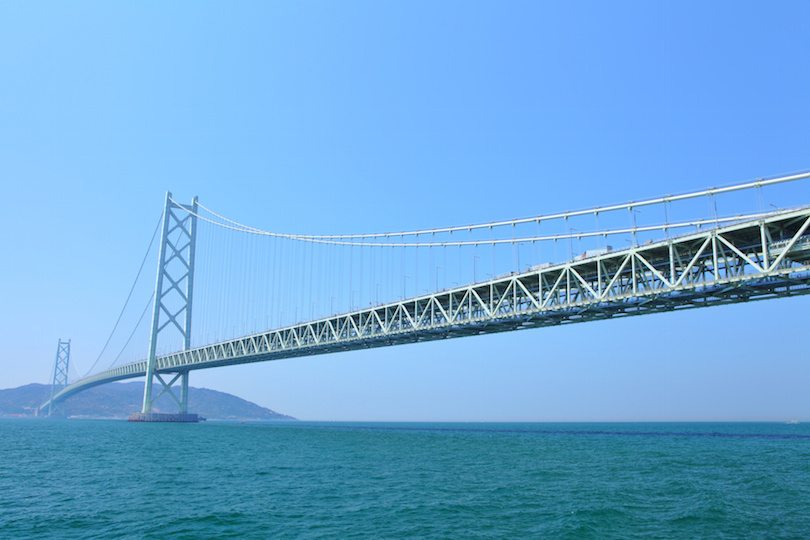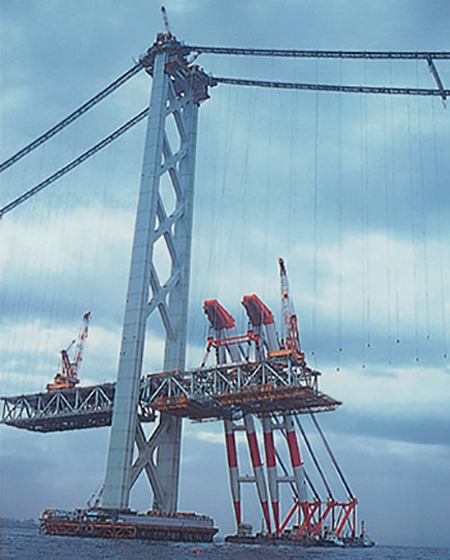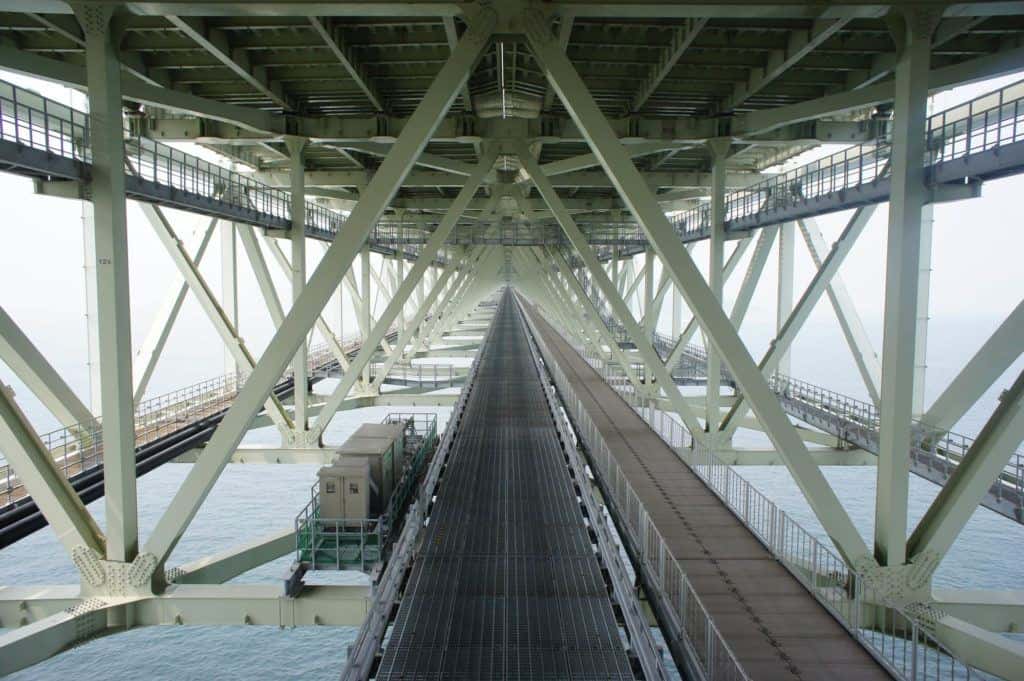As a longest span bridge type, a great number of suspension bridges have been built. Akashi Kaikyo Bridge in Japan, with a truss stiffen girder, set the bridge span record to 1991 m (Miyata, 2013. The central span is staggering 1,991 metres (6,532 ft) making it a truly marvelous civil engineer wonder. Located in Japan, Akashi Kaikyo Bridge was completed in 1998 with the purpose of linking the city of Kobe on the mainland of Honsho to Iwaya on Awaji Island by crossing the busy Akashi Strait. Construction Details. Opened in 1998, it spans the Akashi Strait (Akashi Kaikyo) between Kobe and Awaji Island and is part of the Kobe-Awaji-Naruto Expressway. Prior to the bridge’s construction, the strait was considered one of the world’s most dangerous waterways. For instance, in 1955 a severe storm caused two ferries to sink resulting in the deaths of 168.
- Akashi Kaikyo Bridge Construction Process Fast Week 1
- Akashi Kaikyo Suspension Bridge
- Akashi Kaikyo Bridge Feature
- Akashi Kaikyo Bridge Construction Process Fast Week 5
- Akashi Kaikyo Bridge Construction Process Fast Week 9
Akashi Kaikyo Bridge, also called the Pearl Bridge Japan, became the world’s longest suspension bridge when measured by the length of its main span in 1998. It retains that ranking today. The other famous bridges on the top five longest list include the Xihoumen Bridge in China, the Great Belt Bridge in Denmark, the Runyang Bridge over the Yangtze River in China, and the Humber Bridge in England.
The Pearl Bridge Japan suspension bridge spans the Akashi Strait, connecting the city of Kobe on Honshu Island to Awaji Island. The Akashi Strait is part of the Inland Sea, a significant and busy international waterway that touches on the important port of Osaka. One of the facts about the Akashi Kaikyo Bridge is that it provides a critical and cost-saving transportation link to the three main islands of Japan.
The Akashi Kaikyo Bridge also provides more economical and faster transportation to Yamaguchi, Hiroshima, and Kagawa. The Pearl Bridge Japan even makes getting to the city of Iwakuni and the famous stone Kintai Bridge easier. The Kintai Bridge is one of the most famous bridges in all of Japan. Built in the seventeenth century, it is an elegant historic structure around which several thousand trees burst out in beautiful cherry blossoms each spring.
Japan Map
The historical facts about the Akashi Kaikyo Bridge began as long ago as 1955, when a ferry crossing the Akashi Strait sank when it collided with another ferry. A total of 168 people, mostly children, on the first ferry drowned in the disaster. Engineers and planners were faced with the challenge of creating a bridge that would withstand earthquakes, tsunamis, and hurricanes. They needed a structure that would not impede busy and crucial commercial shipping. The current structure has withstood the 1995 Kobe earthquake that measured 6.8 on the Richter scale and can weather winds up to 180-miles-per-hour.
Construction on the Akashi Kaikyo Bridge finally began in 1988. Ten years and 2 million workers later, the bridge was opened in 1998. It was a monumental engineering feat that required enough steel cable to encircle the earth seven times. It ranks with the huge Three Gorges Dam on the Yangtze River in China, the Petronas Towers in Malaysia, Palm Deira Island in Dubai, the Bird’s Nest Stadium of the Beijing Summer Olympics, and the Viaduct de Millau in France as one of the greatest engineering marvels of the last couple centuries.
Other fascinating facts about the Akashi Kaikyo Bridge include its length of 12,828 feet, long enough to accommodate the Brooklyn Bridge four times. You can lay eight Chicago Willis Towers along its length. It is one of the longest bridges in the world, and is the world's largest suspension bridge. Its towers also enter into any book of records. They are 928 feet high, making it the third tallest in the world, after the Villau Viaduct and the Sutong Bridge in China. Being the tallest doesn’t necessarily make it the highest. Highest is measured by distance between the surface of the bridge and the ground/water surface below. By this standard, the Royal Gorge Bridge in Canon City, Colorado, is higher. Even though its towers are only 150 feet long, it is a fairly breathtaking 1,053 feet above the canyon floor and river below.
The Akashi Kaikyo Bridge (AKB) is a three-span, two-hinged
stiffening girder system suspension bridge that spans the Akashi
Strait, connecting the Japanese mainland at Maiko, Taruni-ward in
Kobe with Matsuho on Awaji Island. It is part of the ongoing Honshu-
Shikoku Bridge Authority (HSBA) project to link the islands of
Honshu, Awaji and Shikoku.
Akashi Kaikyo Bridge Construction Process Fast Week 1
After 10 years of construction and a total cost of $3.6 billion, AKB
opened on April 5, 1998, measuring 3,911 m long with a center span
of 1,991 m. AKB is the longest suspension bridge in the world by 581
m, surpassing the Humber Bridge in England, which has a center span
of 1,410 m.


Initially, the bridge measured 3,910 m but was lengthened 1 m mid-
construction when the bridge was shaken by the Great Hanshin
Earthquake measuring 7.2 on the Richter scale in January 1995. The
bridge suffered no major damage other than the vertical and lateral
offset to the Awaji tower and anchorage, resulting in the AKB being
lengthened by one meter.
In June, the AKB was presented the George S. Richardson Medal for a
single, outstanding achievement at the International Bridge
Conference by the Engineer's Society of Western Pennsylvania. (See
Richardson and Roebling Awards Presented at IBC, July 1998, p 19).
In recognition of this honor, ROADS & BRIDGES provides an in-depth
examination, deconstructing the elements necessary to piece together
the engineering marvel known as the AKB.
Design standards
As the length of a bridge's center span increases,
the structure's stability becomes more susceptible to natural forces.
When designing the AKB, the Public Works Research Institute (PWRI)
constructed a 1:100 scale model and put it through repeated testing
in order to develop a superstructure stable enough to withstand the
80-m-per-second winds of the Strait.
'The PWRI played a vital role in the aerodynamic investigation of the
bridge,' said James D. Cooper, chief of the Structures Research
Division, Turner-Fairbank Highway Research Center, Federal Highway
Administration. 'The HSBA contracted with the PWRI to build a large
wind tunnel which was then used to investigate the aerodynamic
behavior of the 1:100 model of the AKB.'
Additionally, two types of earthquakes were calculated as factors in
designing the bridge: an earthquake of magnitude 8.5 on the Richter
scale with an epicenter distance of 150 km; and an earthquake
occurring with a recurrent cycle of 150 years within a 300 km of
radius of the bridge site.Results from these tests were then incorporated into the design
standards of the AKB.
Main tower foundations
The foundations of the two main towers
of the AKB are structurally vital in that they transfer the
approximately 120,000-tons of downward load from the huge main
towers to the supporting ground.
'The most challenging parts of the bridge's construction were
physical,' said Cooper. 'First, designing a bridge at the threshold of a
2,000-m main span length that could carry a significant live load
using advanced traditional materials or high strength steels while
working under severe constraints imposed by the environment
including tidal currents of up to 4.5-m-per-second, winds up to 8-m-
per-second and tectonic activity at the bridge site.'
Strong currents (4.5-m-per-second), deep water (110 m), wind and
waves are what workers battled when it came to laying and
completing the foundations for AKB's main towers. Designed to
transmit the 120,000-ton weight of the bridge from the support
towers to the support ground, which is 60 m under water, excavation
by a grab bucket dredger proved to be tedious. Additionally, the
excavation process had to be within a vertical variation of /-10 cm
for the caisson installation in order to prevent the foundation
caissons from tilting.
Manufactured beforehand, the caissons were towed to the site,
submerged, filled with underwater and standard concrete and then
sunk.
'Due to the extremely demanding physical conditions of the Akashi
Strait, special considerations had to be given to ensure navigational
safety and environmental preservation,' said Yoshikazu Fujiwara,
president of HSBA.
It took two days to set the caissons in place because careful attention
was paid to the positioning of caissons and the sea level at each
particular moment. Lasers and ultrasonic measuring devices were
used to guarantee precise and accurate installation.
A variety of high-tech equipment was introduced and new
technologies and materials were developed especially for the
construction work. For the foundations, a new type of underwater
concrete, 'underwater nondisintegration concrete,' was developed.
Advantageous in terms of fluidity and consistency, it can be poured
for long distances without a weak layer forming on its surface.
'Construction progressed steadily through comprehensive use of
advanced bridging technology and where necessary the development
of new technology,' said Fujiwara.
Constructing the anchorages
Since the anchorages, which hold AKB
in place, had to be constructed on the shores of the Strait. This was
possible only after the work bases had been built on reclaimed land.
According to the HSBA, the underground slurry wall method was
employed for the 1A anchorage on the Kobe side and artificial
bedrock was constructed, creating one of the largest bridge
foundations in the world. For the 4A anchorage on the Awaji Island
side, a spread foundation construction method using retaining walls
was employed. The supporting stratum of the site was inclined both
in the bridge axis direction and in the transverse direction. Because
of this, retaining walls were installed in six layers of blocks fitting
the contours of the site.
For the 1A anchorages, retaining walls arranged in circular form
were installed first and the soil inside these retaining walls was
excavated in the open-air while the ground water inside was
pumped out. A continuous underground wall with 92 sections of the
same length was constructed using an excavator for continuous wall
construction. Using this retaining wall, the 85-m-diam area was
excavated. The excavation work was started at 2.5 m above sea level
and reached 61 m below sea level, taking about 11 months in total to
complete, during which approximately 330,000 cu m of soil was
excavated. After the excavation, roller-compacted concrete was
applied to make a foundation consolidated with the retaining wall.
The supporting ground for the 4A anchorage was granite. Among the
four foundations supporting the bridge, only this ground was strong
enough to support the bridge by itself. This supporting ground,
however, was slanted. Because of this, a spread foundation was
chosen while stability was secured through structural design. In
consideration of the fact that the supporting ground existed, 15-25 m
below the surface level and that this was reclaimed land, a pillar-
supported continuous retaining wall method was used. In this
method, pillar piles are driven into the ground first to construct
retaining walls and then the inside is excavated.
Next came the installation of the cable anchor frame, a steel structure
used to tie down a cable, that was eventually buried by cement in
the anchorage.
The main bodies of the anchorages, which support the tension of the
cables, were made from highly workable concrete. This concrete,
which is highly fluid and needed no compacting, greatly increased
efficiency in casting and reduced construction time.

Erecting the main towers
According to the HSBA, while
constructing the 282.2-m-high main towers, it was important to
maintain vertical precision. Therefore, in manufacturing its structural
members, precision processing was applied. A high level of precision
was realized by checking the gap between the two touching surfaces
with a gap gauge that was only 0.04 mm thick.

The tower top saddles transmit the 100,000-ton weight of the bridge
from the cables to the foundations. The towers are divided
horizontally into 30 tiers of approximately 10-m-high prefabricated
steel on top of each other. Each of the segments are divided with
three separate blocks so as not to exceed 160 tons in weight.
During construction, a climbing crane was used, and the crane
operator and foreman concentrated their efforts to place blocks one
on top of the other with great precision.
Akashi Kaikyo Suspension Bridge
At a height of 282.8 m, rivaling the height of the Tokyo Tower, the
towers are subject to influence from the wind. To counteract this,
they were designed cruciform in cross section and have been
equipped with stabilizers called tuned mass dampers (TMD).
The TMD's are located in each tower to counteract deflective and
torsional vibration caused by wind and reduce tower vibration
during an earthquake. Weighing about 10 tons each, 20 of the TMD's
are distributed on the 17th, 18th and 21st tiers of the tower.
Installing the cables
The first stage of cable installation was the
pilot rope spanning, which was done by helicopter. Using light-
weight, high-strength poly-aramid fiber rope measuring 10 mm in
diameter, the pilot rope, attached to each anchorage, was installed
over each span in succession. It was used to suspend the catwalk
from which work on the main cables would proceed.
Each cable, 4 km in length, is composed of 290 strands, each strand
containing 127 wires made of high-tensile galvanized steel and
measuring 5.23 mm in diameter. The strands are hexagonal in shape
and factory produced beforehand, in what is known as the
prefabricated strand method.
One of the biggest technological advances achieved in constructing
the bridge was the improvement in wire tensile strength. Although
prior to construction of the AKB the wire tensile strength was only
160 kgf/sq mm, a new wire with an increased tensile strength of 180
kgf/sq mm was developed for the AKB, making it possible to use
only one cable per side instead of two.
'The use of higher strength steel kept the diameter of the main cable
to a reasonable 1.12 m,' said Cooper. 'The most significant
achievement was the advancement of technology and use of
prefabricated parallel wire strand for the construction of the main
cable. This technology probably also improved worker safety
conditions on the job, relative to worker exposure when using cable
spinning on the job.
'Another unique feature of the main cable system is the corrosion
protection system selected, which incorporates a dehumidified
system to reduce moisture content of the air contained in the
enclosed cable,' said Cooper.
Stiffening steel girders
In the final stage before completion, 90,000 tons of steel was used in
constructing the stiffening girders, which are 35 m wide and 14 m
high. The girders were assembled into large blocks of roughly 3,000
tons, which were then installed as single units using floating crane
ships. Due to the tremendous size of the bridge, the wind load they
sustain is greater than that of any other bridge in existence,
according to the HSBA. Using high tensile strength steel made the
girders very strong, relatively light and therefore more economical.
The stiffening girder construction, by the plane block method, began
at the main towers and anchorages, where the floating crane was
used to install six panel blocks on the towers and eight on the
anchorages.
Akashi Kaikyo Bridge Feature

To reduce stiffening girder torsional vibration caused by wind,
stabilizing plates were installed under the median strip of the deck.
The stabilizers act to guide the wind, reducing torsional vibration by
achieving a balance between pressures on the lower and upper
surfaces.
'The Japanese skillfully developed and honed their design,
fabrication and construction techniques to the point where the
challenge of building the world's longest suspension bridge could
successfully be met,' said Cooper.
Experience aides completion
Akashi Kaikyo Bridge Construction Process Fast Week 5
Honshu-Shikoku Bridge Authority,
established in 1970, gained significant experience in the design and
construction of the Seto-Chuo Expressway route, according to Cooper.
The first of three crossings between the islands of Honshu and
Shikoku, major experience was gained in the design and construction
of the Seto Ohashi Bridge on that route, which provided the
experience and confidence to propose, design and construct the AKB.
'The safety record for the AKB project sums up the handling of the
construction process,' said Cooper. 'No fatalities, with a half dozen
injuries on the world's longest suspension bridge construction project
that spanned more than 10 years.'
Akashi Kaikyo Bridge Construction Process Fast Week 9
Fujiwara added, 'With the opening of the Bridge, I express my
deepest gratitude to the local residents and all of those who have
rendered their tremendous assistance and support.'
